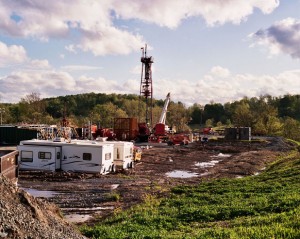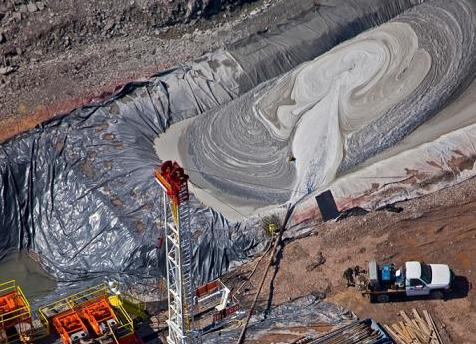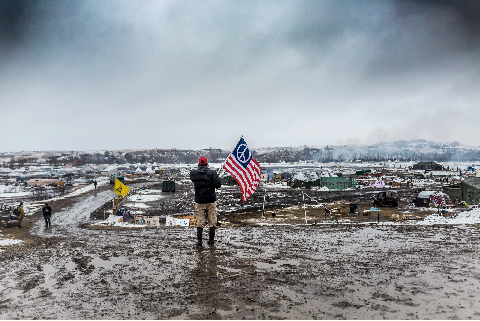
PA Attorney General Releases Scathing Grand Jury Report on Fracking Industry, State Regulators
June 29, 2020
NY State Legislation Classifies Frack Waste as Hazardous
August 25, 2020By Hiroko Tabuchi and Brad Plumer, New York Times, July 8, 2020
Protesters against the Dakota Access pipeline in early 2017. On Monday, a court ruled the pipeline project must be shut down pending an environmental review.
They are among the nation’s most significant infrastructure projects: More than 9,000 miles of oil and gas pipelines in the United States are currently being built or expanded, and another 12,500 miles have been approved or announced — together, almost enough to circle the Earth.
Now, however, pipeline projects like these are being challenged as never before as protests spread, economics shift, environmentalists mount increasingly sophisticated legal attacks and more states seek to reduce their use of fossil fuels to address climate change.
On Monday, a federal judge ruled that the Dakota Access Pipeline, an oil route from North Dakota to Illinois that has triggered intense protests from Native American groups, must shut down pending a new environmental review. That same day, the Supreme Court rejected a request by the Trump administration to allow construction of the long-delayed Keystone XL oil pipeline, which would carry crude from Canada to Nebraska and has faced challenges by environmentalists for nearly a decade.
The day before, two of the nation’s largest utilities announced they had canceled the Atlantic Coast Pipeline, which would have transported natural gas across the Appalachian Trail and into Virginia and North Carolina, after environmental lawsuits and delays had increased the estimated price tag of the project to $8 billion from $5 billion. And earlier this year, New York State, which is aiming to drastically reduce its greenhouse gas emissions, blocked two different proposed natural gas lines into the state by withholding water permits.
The roughly 3,000 miles of affected pipelines represent just a fraction of the planned build-out nationwide. Still, the setbacks underscore the increasing obstacles that pipeline construction faces, particularly in regions like the Northeast where local governments have pushed for a quicker transition to renewable energy. Many of the biggest remaining pipeline projects are in fossil-fuel-friendly states along the Gulf Coast, and even a few there — like the Permian Highway Pipeline in Texas — are now facing backlash.
“You cannot build anything big in energy infrastructure in the United States outside of specific areas like Texas and Louisiana, and you’re not even safe in those jurisdictions,” said Brandon Barnes, a senior litigation analyst with Bloomberg Intelligence.
The growing opposition represents a break from the past decade, when energy companies laid down tens of thousands of miles of new pipelines to transport oil and gas from newly accessible shale formations in North Dakota, Texas and the Appalachian region.
Between 2008 and 2019, oil production in the United States more than doubled and gas production increased by more than 60 percent as a result of new drilling techniques known as hydraulic fracturing, or fracking. Electric utilities have built hundreds of new natural gas power plants, and the United States has transformed itself from a gas importer to an energy superpower looking to build export terminals to ship oil and gas overseas.
In recent years, however, environmental groups have grown increasingly sophisticated at mounting legal challenges to the federal and state permits that these pipelines need for approval, raising objections over a wide variety of issues, such as the pipelines’ effects on waterways or on the endangered species that live in their path.
Strong grass roots coalitions, including many Indigenous groups, that understand both the legal landscape and the intricacies of the pipeline projects have led the pushback. And the Trump administration has moved some of the projects forward on shaky legal ground, making challenging them slightly easier, said Jared M. Margolis, a staff attorney for the Center for Biological Diversity.
For the Dakota and Keystone XL pipelines in particular, Mr. Margolis said, the federal government approved projects and permits without the complete analyses required under environmental laws. “The lack of compliance from this administration is just so stark, and the violations so clear cut, that courts have no choice but to rule in favor of opponents,” he said.
Energy Transfer, the Dakota pipeline’s operator, has said it believes the ruling “is not supported by the law or the facts of the case” and that it will seek to stay or appeal the decision. TC Energy, which is building the Keystone XL pipeline, has said the decision would cost jobs.
Even when energy companies ultimately prevail, as the backers of the Atlantic Coast Pipeline recently did at the Supreme Court over a permit to cross the Appalachian Trail, the delays can be costly.
Between 2009 and 2018, the average amount of time it took for a gas pipeline crossing interstate lines to receive federal approval to begin construction went up sharply, from around 386 days at the beginning of the period to 587 days toward the end. And lengthy delays, Mr. Barnes said, can add hundreds of millions of dollars to the cost of such projects.
In the meantime, the entire energy industry is wrestling with the economic fallout from the coronavirus pandemic, which has caused demand for oil and gas to drop worldwide. Falling energy prices further complicate the financial case for new pipelines.
“We’d expect the demand for new pipelines over the next few years to be lower anyway,” said Stephen Ellis, an energy and utilities strategist at Morningstar Research, “even setting aside all the legal issues and growing community opposition.”
Mr. Ellis added that, in some areas, the pipeline disruptions could put added pressure on oil and gas producers. The Dakota Access Pipeline had been transporting 557,000 barrels of oil per day from the Bakken shale formation in North Dakota. With the pipeline shut down, many energy producers may struggle to ship their oil by rail instead.
Over the past week, both the Trump administration and the fossil-fuel industry have expressed growing frustration with environmentalist opposition around pipelines.
“Our nation’s outdated and convoluted permitting rules are opening the door for a barrage of baseless, activist-led litigation, undermining American energy progress and denying local communities the environmental, employment and economic benefits modern pipelines provide,” Mike Sommers, president and chief executive of the American Petroleum Institute, said in a statement.
A slump in American exports of liquefied natural gas — natural gas cooled to a liquid state for easier transport — has also weighed heavily on pipeline projects. L.N.G. exports from the United States had boomed in recent years, more than doubling in 2019 and fast making the country the third largest exporter of the fuel in the world, trailing only Qatar and Australia. But the coronavirus health crisis and collapse in demand has cut L.N.G. exports by as much as half, according to data by IHS Markit, a data firm.
Erin M. Blanton, who leads natural gas research at Columbia University’s Center on Global Energy Policy, said the slump would have a long-term effect on investment in export infrastructure. The trade war with China, one of the largest growth markets for L.N.G. exports, has also sapped demand, she said.
“We haven’t seen a contract signed with China since the trade war began,” she said, adding that it could be a couple years before export projects see investments again. “And if you don’t have an additional L.N.G. terminal getting built, it’s unlikely that you’ll also be building the pipeline to feed that terminal,” she said.
Still, domestically, natural gas remains in the picture, she said. Even with the effects of the coronavirus, gas use for electricity has not declined significantly. “You still have a lot of projects still in the works, because there is still demand,” she said.
Energy companies and utilities say that many parts of the country still need new pipelines to deliver natural gas to run power plants and heat homes. In New York, supporters of the now-canceled pipelines had warned of shortages and price spikes without new infrastructure. But even this argument often gets pushback.
Last year in Virginia, a coalition of technology companies including Microsoft and Apple wrote a letter to Dominion, one of the utilities backing the Atlantic Coast pipeline, questioning its plans to build new natural gas power plants in the state, arguing that sources like solar power and battery storage were becoming a viable alternative as their prices fell. And earlier this year, Virginia’s legislature passed a law requiring Dominion to significantly expand its investments in renewable energy.
“As states are pushing to get greener, they’re starting to question whether they really need all this pipeline infrastructure,” said Christine Tezak, managing director at ClearView Energy Partners.
For now, the opposition to pipelines is hardly universal. Plenty are still being built in Texas, where state regulators look more favorably on fossil-fuel projects and oil and gas production was booming before the coronavirus pandemic hit. Energy companies have often run into less opposition when they expand the capacity of existing pipelines. And though the Supreme Court ruled against the Keystone XL pipeline, it temporarily revived a permit program that would let other oil and gas pipelines cross waterways after relatively modest scrutiny from regulators.
Even some of the pipelines currently being challenged in court may ultimately prevail. Ms. Tezak of ClearView said the $4.7 billion Mountain Valley Pipeline, which would transport natural gas 300 miles from West Virginia to Virginia, still appeared to be on track to get approval for its permits later this year despite extensive environmental opposition.
But new fronts in the pipeline wars continue to open up. In Texas, landowners and environmentalists have challenged the Permian Highway Pipeline, warning of the risks of spills to nearby drinking-water supplies. In Michigan, environmentalists have pushed Governor Gretchen Whitmer to follow through on a campaign promise to shut down Enbridge’s aging Line 5 oil pipeline.
The presidential election also looms.
President Trump has vowed to expand America’s oil and gas infrastructure and his administration has pushed to limit the ability of states to challenge pipelines. But Democrats have signaled they would subject oil and gas infrastructure to much stricter scrutiny should they take power. One frequently discussed option, endorsed by House Democrats in their climate plan released last week, would be for the federal government to require new gas pipelines to more fully account for their greenhouse gas emissions impacts as they seek permits.
Climate will also play a larger role in future legal challenges, environmental groups said. “The era of multibillion dollar investment in fossil fuel infrastructure is over,” said Jan Hasselman, an attorney at the environmental group Earthjustice. “Again and again, we see these projects failing to pass muster legally and economically in light of local opposition.”




